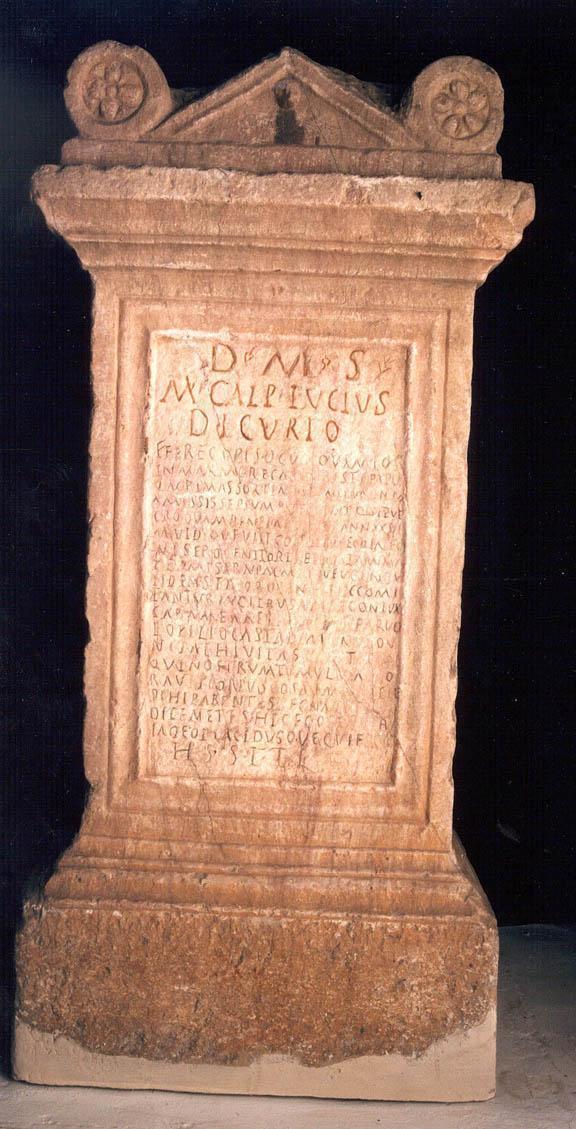Epitaph of Marcus Calpurnius Lucius
Reference CIL II, 1088; CLE 541 | Description | Lyrics | Location | Chronology | Epigraphic edition | Translation | Apparatus | Comentary | Type of verse | Text divided into verses and metric signs | Images | Bibliography | Link to DB | Author |
Epitaph of Marcus Calpurnius Lucius
Description
- Idno filename 22/01/0028
- Type of inscription: Sepulcralis
- Support: Altar
- Material: Marble Material Description: Pink colour.
- Conservation status: Eroded.
- Dimensions height/width/depth (cm): 120.5/57.5/41.5
-
Epigraphic field:
- Layout: Inscribed face framed by two mouldings, one of which frames the epigraphical field; this is eroded with various cracks across it, which makes reading difficult. Frequent abbreviations. Poor layout not respecting verse or syllable boundaries. Hederae and palma in l. 1, triangular interpunction in the rest.
- Epigraphic field dimensions hieght/weight (cm): 51.2/29
- Decoration: Supported on a frieze and podium, with mouldings in the base and the cornice; on top of the cornice there is a triangular pediment finished off with a small circle in relief. On each side of the pediment there is a pulvinus tied with a cord and with flowers on the front face. A focus on the upper part; patera in relief on the right-hand side of the stone, praefericulum on the left.
- Preserved
Lyrics
- Font:Libraria
- Letter size:Approximately 3 in the praescriptum and 1.5 in the carmen. cm
Location
- Place of discovery: Found in Alcalá del Río (Ilipa) on 28 December 1748.
- Geolocation
- Conservation location: Currently in the MAP in Seville.
- Inventory number: 221
- Location with Modern Nomenclature España / Sevilla / Alcalá del Río
- Location with Old Nomenclature Hispania / Baetica / Hispalensis / Ilipa
Chronology
- Inscription's dating: Between year 170 and year 230
- Dating explanation: End of 2nd c. or beginning of the 3rd from the type of letter and the abbreviation of the nomen Calpurnius (GONZÁLEZ FERNÁNDEZ).
Type of verse
- Type of verse: Dactílico (hexámetro)
- Verse/line correspondence: No
- Prose/verse distinction: Si
Epigraphic edition
D(is) ▴ M(anibus) ▴ s(acrum) ▴
M(arcus)▴ Calp(urnius) ▴ Lucius
decurio
flere cupis ▴ q(ui)▴cumque meos
5 in marmore casuṣ ▴ siste paru(m)
lacrimas sorte miserandus iniqua
amis{s}isse pium pateṛ dedit(um)▴q(ue) ▴ sepul-
cro quam bene iam gess˹i˺ (!) ann(os) XXVI
m(enses) ▴ VI ▴ d(ies)▴que ▴ VIII ▴ conditus ego iaceo
10 misero genitore relicto iam ma-
ter misera ▴ palmisque ubera tu-
ndens et soror infelix comi-
tantur ▴ luctibus amb(a)e coniux
cara mea relicta cum parvo-
15 lo filio casta mater ▴ vidu[a]
n(un)c mihi vita sup(e)r{e}stat
qui ▴ nostrum tumulum (h)ono-
ravit corpus fo(s)sa im[a] [‑ ‑ ‑]ete
pihi parentes regna qui mun-
20 di tenetes (!) hic ego sepultus
iaceo placidusque quiesco
h(ic) ▴ s(itus) ▴ s(it) ▴ t(ibi) ▴ t(erra) ▴ l(evis)
Text divided into verses and metric signs
Flere cupis quicumque meos in marmore casus, lww|l/l|lw/w|l/l|lww|lx
siste parum lacrimas: sorte miserandus iniqua lww|l/ww|l/l|w/ww|lww|lx*
amisisse pium pater deditumque sepulcro. ll|lww|l/w|l/ww|lww|lx*
quam bene iam gessi annos XXVI menses VI diesque VIII!
5 conditus ego iaceo, misero genitore relicto; lww|wwww|lw/w|l/ww|lww|lx*
iam mater misera, palmisque ubera tundens, lww|l/ww|w/l|lwH|lww|lx*
et soror infelix comitantur luctibus ambae. lww|ll|l/ww|ll|lww|lx
coniux cara mea, relicta cum parvolo filio, ll|lww|w/w|lwl|lwl|lx*
casta mater vidua nunc mihi vita superstat, lwl|lww|w/l|wl|lww|lx*
10 quae nostrum tumulum honoravit. corpus fossa ima ll|l/ww|l …
[fl]ete, pihi parentes regna qui mundi tenetis. wl|wl|ll|wl|llw|lx*
hic ego sepultus iaceo placidusque quiesco. lww|wl|lww|lww|lww|lx*
Translation
“Dedicated to the Manes. Marcus Calpurnius Lucius, decurion. Whoever wishes to weep for my fate at this stone, hold back your tears for a moment. (It is) my father who deserves pity for his unjust fortune: having lost me, a dutiful son, and delivered me to the grave. How happily I lived for twenty-six years, six months and eight days! Here am I buried, leaving my poor father abandoned. My poor mother, striking her breast with her hands, and my unfortunate sister both accompany him in his lamenting. My beloved wife, abandoned with a small child, an irreproachable mother, now a widow, survives me. She prepared my tomb. [Grieve for] my body in the deep grave, dear parents, you who live in the kingdom of mortals: I lie buried here and rest in peace. Here (lies) buried. May the earth rest lightly on you.”
Bibliography
Hosius 1895, 286–300 (290 et 299); Hübner, II 1088 (inde Bücheler, CLE 541, cuius exemplum in linguam Hispanicam vertit Fernández Martínez 1998-99; Vives, ILER 5798); Cholodniak 1904, 667; Wick 1909, 173–199; Löfstedt 1910, 161–184; Hernández Díaz – Sancho – Collantes 1939, 93; Gil 1976, 561; Fernández-Chicarro – Fernández Gómez 1980, 117–119; Millán 1989, 177; González Fernández, CILA II, 305, cum im. phot.; Thigpen 1995, 34–40 n. 2, quae in linguam Anglicam vertit; Carande – Fernández Martínez 2003, 287–312; Fernández Martínez – Carande, CLEB, SE1, cum im. phot, quae in linguam Hispanicam verterunt. – Cf. Mariner 1952, 17, 36, 38, 46, 79, 81–82, 204 et n. 62; Cugusi 2007, 106.
Apparatus
4 quicumque Hübner. – 6 lacrima(n)s Cholodniak, Thigpen 1995, iniqua(m) González Fernández. – 7 patre? Hübner, patre(m) Cholodniak, Thigpen, pa[tre(m)] González Fernández, deditq(ue?) Hübner, dedi[sse] Cholodniak, Thigpen. – 8 quam pene ia [—] esse Hübner, im[pl]esse(m) González Fernández, gess˹i˺ legimus in 2003. – 9 d(ierum)que Cholodniak, Thigpen; filio pro nato Gil. – 15 vidua Hübner. – 16 no(n)? mihi Hübner, Fernández-Chicarro – Fernández Gómez, Millán; supe(r)stat Hübner, Bücheler; nunc mi invita superstat Gil, González Fernández. – 17 qu(a)e González Fernández; onoravit pro onorabit Cholodniak, Thigpen. – 18 fosaimaqiiet Hübner, e[iu]s a(n)ima(m)que [a]t s(e recipiant) Cholodniak, fos(s) a ima? q[ui]ete? González Fernández, fosaimaqiiets = fos(s)a ima (aut postrema) ciete Thigpen. – 18 regnaque Hübner, Cholodniak; onorauit pro onorabit Bücheler, Cholodniak, Thigpen. – 20 tenet(i)s González Fernández, tene(n)tes Cholodniak; sepultus pro securus Bücheler, Gil.
Comentary
Funerary poem in dactylic hexameters with irregular quantities due to stress intereference; L. 2 with a short E in the ablative sorte presents a tribrach in the 4th foot; L. 3 has a third trochaic foot; L. 5 presents an unnecesary proceleusmatic in the 2nd foot, whose solution is to replace ego for hic; L. 6 presents a short third foot in a stressed position, hiatus between the 4th (throcaic) foot and the 5th; L. 8: brevis in longo in the third foot and three cretics in 4th, 5th and 6th foot; L. 9: cretic in the first foot, brevis in longo in 3rd and 4th foot; iambic sequences in L. 9 and iamb in the 2nd foot of l. 10.
Praescriptum in ll. 1 to 3. Omission in l. 5 of the -m of paru, for phonetic reasons and because it is in margine; in contrast, an -h- is added in l. 19 pihi as a diacritic to avoid contraction (cf. Fernández Martínez 1995, 271-280). Various cases of i/e confusion: l. 8 gesse, 20 tenetes and perhaps 17 qui for que -with monophthongisation as in l. 13 ambe- unless it is a case of extending a masculine form to the feminine (cf. Väänänen 1967, § 285). In l. 16, consonantal metathesis in suprestat (cf., also in Baetica, Vives, ICERV 287); this meaning of “survive” is not otherwise documented until the 6th c. AD. (Ennod., epist. 9,21,1). In ll. 17-18, onoravit is missing the initial h-, which had not been pronounced for centuries (cf. Fernández Martínez 1995, 271-280); it is definitely a future form. In l. 18, the ending -ete seems to require a second-conjugation verb (flete, dolete, lugete, saluete…). Simplification of geminates in l. 18 fosa, and the opposite in l. 7 amississe.
The content of the carmen contains various topoi, expressed in the first person by the deceased. After the appeal to the passer-by in ll. 4 to 6 (cf. Lier 1903 and 1904, Lattimore 1962 and Fernández Martínez 1998-1999, 37, n. 67), his father is presented as deserving pity due to this sorte iniqua (ll. 6-8, cf. Verg., Aen. 6,332; 12,243); the noting of the age breaks the metric structure (ll. 8-9; for the expression quam bene, cf. CLE 1403,17; 1549,15, etc.; for gerere annos, CLE 2202,3; 511,4), and this is followed by an emphasis on the desolation of the family left behind (ll. 10-16; for 11-12 ubera tundens, cf. Ov. Ars 1,535). On these epigraphical motifs, cf. Lier 1903, 453, 456, 464, 466; Lattimore 1962, 203, 205. Finally, ll. 17 to 21 express the contrast between the serene burial of Calpurnius and the grief of those who are left behind; the deceased bids them farewell (cf. Krummrey 1961) meditating on the peace of the tomb (cf. CLE 1964,2; 2180,4, etc.). This is followed by the usual subscriptum, although it is lacking the form est.
Author
- Author:R. Carande Herrero, C. Fernández Martínez
- Last Update2024-02-26 23:24:36
- Autopsy date:2001
You can download this





